See what Paris could have had instead of the Eiffel Tower
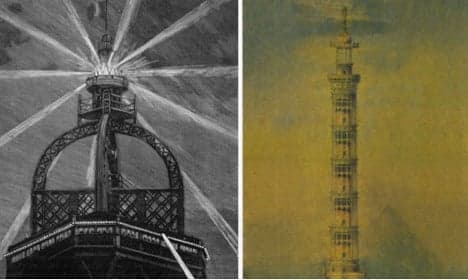
Did you know that there was once a plan to build an enormous sun tower in Paris, an overly ambitious plan that eventually lost out to the Eiffel Tower?
The Eiffel Tower is the symbol of Paris. It's the setting for countless marriage proposals and perhaps billions of tourist photos.
But back in 1885, it wasn't the only building competing to become the focal point of Paris.
The French capital needed another kind of enormous tower, argued Jules Bourdais, an architect with grand plans for a "sun tower" that he claimed would illuminate the whole city.
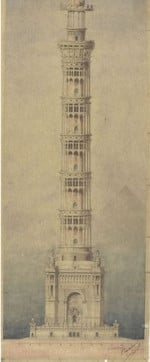 His tower, pictured right, was inspired by French engineer Sébillot who had just returned from the US in the early 1880s.
Together, they planned to build a 300-metre tower which came complete with an electric lamp "to illuminate Paris". The lighthouse section would have given an extra 55 metres in height, taking the tower to 355 metres.
The Eiffel Tower measures 300 metres.
The Musée d'Orsay in Paris, which features some of the works of Bourdais, notes that the sun tower was planned to "easily light up the Bois de Boulogne and the whole of Neuilly and Levallois as far as the Seine!"
It was to be built in granite, with a masonry core surrounded by a series of galleries on top of one another and small cast iron columns.
The light was planned to beam across the city, to be then reflected off strategically placed mirrors around Paris, bathing the capital in light.
The triangular base was designed to be higher than the towers of Notre Dame alone and would have played host to an electricity museum.
And at the very top, the winged statue of the Genius of Science.
Le Figaro newspaper dived into its archives this week, revealing an article from 1885 praising the design of the sun tower.
The writer, Pierre Giffard, marvelled at the project, comparing it to the wonders of the Leaning Tower of Pisa in Italy.
His tower, pictured right, was inspired by French engineer Sébillot who had just returned from the US in the early 1880s.
Together, they planned to build a 300-metre tower which came complete with an electric lamp "to illuminate Paris". The lighthouse section would have given an extra 55 metres in height, taking the tower to 355 metres.
The Eiffel Tower measures 300 metres.
The Musée d'Orsay in Paris, which features some of the works of Bourdais, notes that the sun tower was planned to "easily light up the Bois de Boulogne and the whole of Neuilly and Levallois as far as the Seine!"
It was to be built in granite, with a masonry core surrounded by a series of galleries on top of one another and small cast iron columns.
The light was planned to beam across the city, to be then reflected off strategically placed mirrors around Paris, bathing the capital in light.
The triangular base was designed to be higher than the towers of Notre Dame alone and would have played host to an electricity museum.
And at the very top, the winged statue of the Genius of Science.
Le Figaro newspaper dived into its archives this week, revealing an article from 1885 praising the design of the sun tower.
The writer, Pierre Giffard, marvelled at the project, comparing it to the wonders of the Leaning Tower of Pisa in Italy.
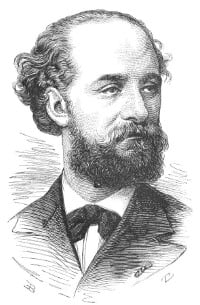 "It differs from the famous Tuscan tower round by an absolute straightness, with such an elevation that no such monument erected by the hand of the man would even reach a third of its height," he trumpeted.
While Bourdais, pictured left, already had a stellar reputation as an architect, the lighthouse idea proved far too ambitious.
The museum noted that the architect had apparently not considered the enormous weight of the monument, the massive foundations it would have needed to support this weight, its instability, or the "outrageous" building costs.
As a result, the idea was passed over for the impressive work of a young Gustave Eiffel - giving us the Eiffel Tower as we know it today.
"It differs from the famous Tuscan tower round by an absolute straightness, with such an elevation that no such monument erected by the hand of the man would even reach a third of its height," he trumpeted.
While Bourdais, pictured left, already had a stellar reputation as an architect, the lighthouse idea proved far too ambitious.
The museum noted that the architect had apparently not considered the enormous weight of the monument, the massive foundations it would have needed to support this weight, its instability, or the "outrageous" building costs.
As a result, the idea was passed over for the impressive work of a young Gustave Eiffel - giving us the Eiffel Tower as we know it today.
And let's not forget that the Eiffel Tower is something of a "sun tower" too - its spotlight which spins 360 degrees each night reaches distances of around 80 kilometres.
As for Bourdais, while he never could claim to be the man behind the tallest (and arguably greatest) building in France, he could be content with an impressive contribution to the landscape of France.
He designed the impressive Trocadero Palace in 1876, which once stood near the Eiffel Tower, and the Town Hall in the 19th arrondissement of Paris in 1878, which still stands today.
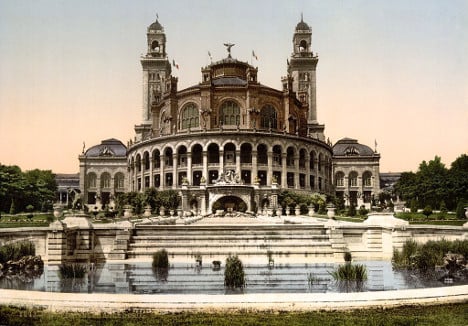 The Trocadero Palace. Photo: WikiCommons
The Trocadero Palace. Photo: WikiCommons
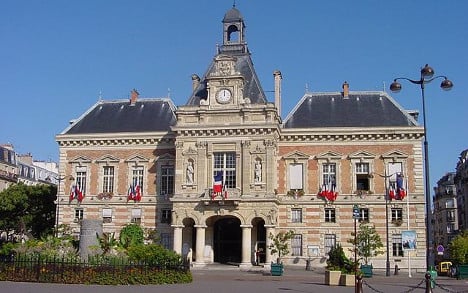 The Town Hall in the 19th. Photo: Patrick Verdier/WikiCommons
The Town Hall in the 19th. Photo: Patrick Verdier/WikiCommons
Comments
See Also
The Eiffel Tower is the symbol of Paris. It's the setting for countless marriage proposals and perhaps billions of tourist photos.
But back in 1885, it wasn't the only building competing to become the focal point of Paris.
The French capital needed another kind of enormous tower, argued Jules Bourdais, an architect with grand plans for a "sun tower" that he claimed would illuminate the whole city.
 His tower, pictured right, was inspired by French engineer Sébillot who had just returned from the US in the early 1880s.
His tower, pictured right, was inspired by French engineer Sébillot who had just returned from the US in the early 1880s.
Together, they planned to build a 300-metre tower which came complete with an electric lamp "to illuminate Paris". The lighthouse section would have given an extra 55 metres in height, taking the tower to 355 metres.
The Eiffel Tower measures 300 metres.
The Musée d'Orsay in Paris, which features some of the works of Bourdais, notes that the sun tower was planned to "easily light up the Bois de Boulogne and the whole of Neuilly and Levallois as far as the Seine!"
It was to be built in granite, with a masonry core surrounded by a series of galleries on top of one another and small cast iron columns.
The light was planned to beam across the city, to be then reflected off strategically placed mirrors around Paris, bathing the capital in light.
The triangular base was designed to be higher than the towers of Notre Dame alone and would have played host to an electricity museum.
And at the very top, the winged statue of the Genius of Science.
Le Figaro newspaper dived into its archives this week, revealing an article from 1885 praising the design of the sun tower.
The writer, Pierre Giffard, marvelled at the project, comparing it to the wonders of the Leaning Tower of Pisa in Italy.

"It differs from the famous Tuscan tower round by an absolute straightness, with such an elevation that no such monument erected by the hand of the man would even reach a third of its height," he trumpeted.
While Bourdais, pictured left, already had a stellar reputation as an architect, the lighthouse idea proved far too ambitious.
The museum noted that the architect had apparently not considered the enormous weight of the monument, the massive foundations it would have needed to support this weight, its instability, or the "outrageous" building costs.
As a result, the idea was passed over for the impressive work of a young Gustave Eiffel - giving us the Eiffel Tower as we know it today.
And let's not forget that the Eiffel Tower is something of a "sun tower" too - its spotlight which spins 360 degrees each night reaches distances of around 80 kilometres.
As for Bourdais, while he never could claim to be the man behind the tallest (and arguably greatest) building in France, he could be content with an impressive contribution to the landscape of France.
He designed the impressive Trocadero Palace in 1876, which once stood near the Eiffel Tower, and the Town Hall in the 19th arrondissement of Paris in 1878, which still stands today.
 The Trocadero Palace. Photo: WikiCommons
The Trocadero Palace. Photo: WikiCommons The Town Hall in the 19th. Photo: Patrick Verdier/WikiCommons
The Town Hall in the 19th. Photo: Patrick Verdier/WikiCommons
Join the conversation in our comments section below. Share your own views and experience and if you have a question or suggestion for our journalists then email us at [email protected].
Please keep comments civil, constructive and on topic – and make sure to read our terms of use before getting involved.
Please log in here to leave a comment.